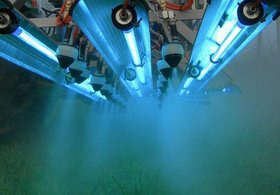
The ability of UV light to sanitize and delay microbial growth on the fresh-cut produce surface without altering its quality has been demonstrated. UV light may be more effective in reducing microbial growth than chlorine, hydrogen peroxide, or ozone.
Recent studies have demonstrated that the UV light treatment may be an effective tool to extend the shelf-life of fresh produce. Generally, UV light wavelength ranges from 100 to 400 nm; this range can be further subdivided into UV-A (315-400 nm), UV-B (280-315 nm), and UV-C (200-280 nm).
 UV-C light is effective in blocking microorganisms development by altering their DNA, furthermore UV-C irradiation at low doses (0.25-8.0 kJ/m2) can induce beneficial reactions in the plant, such as a defence response against pathogens attack, thus phenomenon is known as hormesis.
UV-C light is effective in blocking microorganisms development by altering their DNA, furthermore UV-C irradiation at low doses (0.25-8.0 kJ/m2) can induce beneficial reactions in the plant, such as a defence response against pathogens attack, thus phenomenon is known as hormesis.The aim of hormesis is stimulating an antimicrobial response in fruit and vegetables, many studies have demonstrated that the application of UV-C irradiation at low doses can control many storage rots of fruit and vegetables and delay the fruit ripening during postharvest storage. UV-C light can stimulate in the plant the synthesis of enzymes or compounds with antimicrobial activity.
In 2012, a review on ‘UV radiation effects and its potential application as postharvest technology to preserve fresh fruit and vegetables during storage’ was published on Emirates Journal of Food and Agriculture. Recent studies on UV application as postharvest technology of fresh produce, such as tomato, mushrooms, broccoli, baby spinach, pepper, strawberry, blueberry, apple, watermelon, pomegranate, grapes for wine, papaya, mango and citrus, are reported in the review
Some examples on the antimicrobial and hormetic effects of UV radiation treatment on fresh produce are listed in the following table.
| FRESH PRODUCE | UV-C RADIATION EFFECTS |
| TOMATO | UV-C light can improve the nutritional value and increase the lycopene level without modifying the physical properties of tomatoes during postharvest storage. At low concentrations (about 4 kJ/m2), the UV-C radiation can induce the expression of a number of defence response genes, and suppress the expression of genes involved in cell wall disassembly, lipid metabolism and photosynthesis. The defence response genes delay the tissue softening, preserve the nutritional and sensory attributes, thus they let to extend the shelf-life of tomato fruit. |
| MUSHROOMS | IUV-C radiation has an antimicrobial effect, thus it could be applied as a sanitizer tool on mushrooms. UV-C radiation at doses of 0.45-3.15 kJ/m2 let to reduce Escherichia coli O157:H7 by 0.67-1.13 log CFU/g. |
| BABY SPINACH | UV-C radiation applied at proper doses and to both sides of the baby spinaches could reduce microbial growth and extend the shelf-life without compromising the fresh-cut baby spinach quality. UV-C radiation at doses from 2.4 to 24 kJ/m2 can limit the growth of Listeria monocytogenes, Salmonella enterica, Pseudomonas marginalis, psychrotrophic and Enterobacteriaceae. However, UV-C light applied at low doses is effective on initial microbial reduction at the beginning of storage, for this reason the fresh-cut spinach shelf-life varies from 4 to 5 days at 5°C. |
| BROCCOLI | Floret yellowing is a serious critical issue limiting the shelf-life and quality of broccoli. UV-C radiation applied at doses from 4 to 14 kJ/m2 can retard the chlorophyll degradation and increase the antioxidant activity in the vegetable. |
| PEPPER | UV-C light can reduce the incidence and the severity of chilling injuries on pepper during postharvest storage at low temperatures. UV-C radiation applied at dose of 7 kJ/m2 can retard the symptoms due to chilling injury and maintain the tissue firmness. |
| STRAWBERRY | UV-C radiation applied at doses from 0.43 to 4.30 kJ/m2 can delay the tissue softening acting on antioxidant and enzymatic activity in strawberry. UV-C light treatment at hormetic doses induces the expression of the defence response genes, which stop the cell wall degradation controlling the softening or defend the strawberry fruit against infections, such as the gray mold caused by Botrytis cinerea. |
| BLUEBERRY | UV-C radiation can reduce the berries decay caused by ripe rot (Colletotrichum acutatum) and enhance the antioxidant compounds level, such as total anthocyanin and total phenolics. The optimal UV-C doses to improve the phytochemical properties of blueberries range from 2.15 to 4.30 kJ/m2. |
| APPLE | UV-C radiation applied at the dose of 1.2 kJ/m2 can sanitize the apple surface, stop the oxidative enzymes, prevent tissue browning and off-odors development. In addition, UV light creates a dried protective film which inhibits microbial growth and juice leakage, this film is not perceived by consumer. |
| WATERMELON | UV-C radiation applied at doses from 1.4 to 2.8 kJ/m2 can reduce microbial growth and catalase enzyme activity on fresh-cut watermelon. However, the efficacy of UV-C light depends on initial microbial contamination and surface exposure to the treatment. |
The authors of the review concluded that the UV radiation efficacy in prolonging the fresh produce shelf-life depends on produce (species and variety, intact or minimally processed fruit and vegetables), initial microbial contamination, UV light application system (moment of application, duration and dose of treatment) and on plant surface exposed to the irradiation.
UV-C radiation represents a valid alternative to the sanitizers currently used, which may release residues on the product or altering its quality, however further investigations on UV application system are still necessary as the efficacy of UV treatment can differently change according to the fruit or vegetable.
Original work. Ribeiro C., Canada J., Alvarenga B., "Prospects of UV radiation for application in postharvest technology", 2012, Emirates Journal of Food and Agriculture, Issue No. 24(6), pagg. 586-597. For more information: http://ejfa.info/index.php/ejfa/article/view/14677
